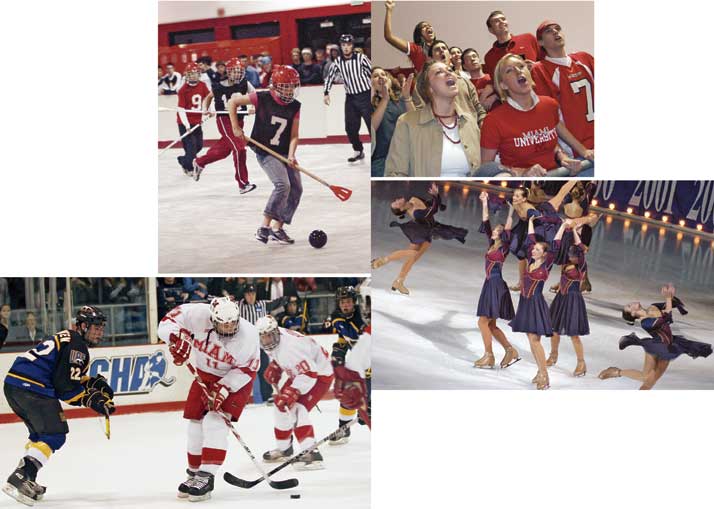
Steve Cady, assistant vice president for finance and business services, inside the Goggin Ice Center, scheduled to open this summer.
By Ted Brengle '02 MA '05
Even as the red bricks went up, naysayers continued voicing their concerns. Miami didn't need an ice arena. And those who conceded it might be a nice addition still questioned its size. It didn't need to be that big.
After all, Miami University's in southwest Ohio, not Michigan or Canada. How many students even knew how to skate? And who wanted to risk looking foolish learning?
No, the ice arena, some predicted, would be an ice-white elephant, an extravagant, little-used toy for a journeyman hockey club guaranteed never to be a varsity program. At least that's what the first coach, Steve Cady, was told during his job interview.
Still, they built it. But would people come?
The arena's inaugural event in the fall of 1976 was a hockey game between Miami and Ohio University.
Aware that Miami didn't have a varsity team, the architects designed the competition rink as a small, intimate space of backless benches that started within a hockey stick's length of the ice. If the doomsayers proved right, and no one showed up for the first game, at least those happy few who came would enjoy great seats.
Imagine the proponents' delight when President Shriver walked out on the ice to drop the puck and start the game and faced an excited, standing-room-only crowd.
Miami won that first game, and the cheers crescendoed, growing in fervor and passion for 30 years. Fire and ice. Red and white. When the hockey team claimed the No. 1 spot in the nation this February, fans with general admission tickets speculated they'd have to arrive two hours early to find a seat for the following weekend's sold-out series.
In other words, the Goggin isn't looking so big these days. That's why in May it's closing its doors and making way for a new arena across campus between Phillips Hall and the rec center.
Everything will be new except the name. Lloyd Goggin MBA '63 is both pleased and flattered by that.
A native of Maine who started skating at age 4, Goggin spearheaded construction of the original arena as vice president for finance and business affairs. Miami recognized his contribution by naming the arena after him in 1984, two years after he retired.
Now in his 80s and still living in Oxford, he faithfully attends Miami hockey games. He's looking forward to a little more elbow room in the new arena.
"When we built the first one, we didn't have any feelings of grandeur at that time," Goggin says. "That building ... I don't want to say it was low key, but it was not large."
Cady, who moved on from hockey coach to arena director (1985-97), explains, "The first Goggin was built with the idea that hockey would never be a varsity sport. There was also no thought about having intramural programs. I was told if you had 10 or 12 teams that would be great."
And no one planned on the skating and hockey schools, which bring 1,500 children and their families from around the nation to Oxford each summer.
"A great number of kids that have been counselors for us, that have attended camps here, have become Miami University students," says Mitch Korn, who was the architect of these summer sessions while Goggin's director of programming. He was overall director of Goggin from 1997 to 2005.
When Korn started, his first project in 1981 was to popularize a little-known sport called broomball, which began with 35 intramural teams, much to everyone's amazement.
"We thought that was just the cat's meow," Korn says. "Thirty-five teams were unbelievable because at the time we had 26 intramural hockey teams."
Perhaps it's fair to say Korn is the father of a campus phenomenon that these days boasts 107 teams and is the largest broomball program in the United States.
For the uninitiated, broomball is played on a hockey rink with rules similar to hockey, except players wear rubber shoes and bat at a ball between the size of a soccer ball and a softball with specially made brooms. Fast and sophisticated it's not.
Korn has some ideas on why the game remains a perennial favorite.
"The sport by definition allows anybody to play. Nobody played varsity broomball in high school so they wouldn't have an advantage over somebody else. And, if you think about college students to a large extent, I think they like being slightly out of control."
While broomball grew in popularity and hockey matured from a club sport to a varsity team, the women's synchronized skating program became internationally renowned. In 1995 Miami's team, then called precision skating, became a varsity sport, the first in the nation. Only four years later, the team won the National Senior Precision Championship, Miami's first national championship in any sport.
With two varsity teams plus more than 8,000 students in intramural programs and a thousand or so students in classes all vying for ice time each semester, the original Goggin has clearly outgrown its modest origins.
That's why the new $32 million Goggin Ice Center is 174,000 square feet, including two sheets of ice - one for varsity activities and the other for recreation and practice. The main arena will seat 3,000, a sizable increase over the original Goggin's 1,800.
Admittedly, with that kind of increase, some worry about losing the interaction between the rowdy spectators and the skaters.
"The intimacy of the building when you put 2,000-plus people in it for game staging is something that we've attempted to create in the construction phase of this new building," says Barry Schutte '97, the Goggin's current director.
Aside from size, just about everything is being upgraded.
"The synchronized skating team right now doesn't have a home," Cady says. "They have an ice surface, but they don't have locker rooms. The largest intercollegiate team, besides football, on campus, plus the largest women's sport, 50-something women, and they don't even have locker rooms. Now they will."
That's great news to Vicki Korn '88, hired as skating director in 1984 to oversee the little precision skating club. While she was building it into a full-scale program and Mitch Korn was doing the same with broomball, they must have found a bit of time for extracurricular skating since they eventually married.
Doing them one better, Schutte, who played hockey at Miami and has the scars to prove it, married Carolyn Hall '01 at center ice, the only wedding the Goggin has hosted.
Memories. The old Goggin houses its share. Scott Hamilton participated in Miami's annual spring ice show in the 1970s before he became famous by winning Olympic gold. In 1987 the Soviet Union team, including the great pairs couple Gordeeva and Grinkov, used Goggin as its practice site before the World Figure Skating Championship in Cincinnati.
"The Goggin is a unique place," Mitch Korn observes. "It is not a typical ice arena. If you looked around at other universities, the average ice arena is like a landlord in an apartment complex. They rent ice, they sit back, and they clean up after you. That's not what we do."
As a result, the people who have been with the original Goggin from the beginning have mixed feelings. Mitch Korn, who still directs the summer hockey schools, likens it to selling the family home after everyone has moved on. But their mild melancholy is tempered with excitement.
"The new building won't replace the old one in terms of memories," Cady admits, "but hopefully we'll create some new ones to add to them."

Clockwise from top left:
With 107 teams, Miami's is the largest broomball program in the nation and one of the largest intramural programs too.
Hockey fans nearly shake the rafters with their enthusiastic screaming and standing-room-only crowds.
The senior synchronized skating team won a second silver medal in three years when it finished second at the Spring Cup in Milan, Italy, in early February. Miami came into the free skate leading but was edged out by Team Berlin for the overall title. At the U.S. National Synchronized Skating Championships in Grand Rapids, Mich., Feb. 25, the team earned gold and was crowned national champions. The RedHawk's collegiate team won its national championship earlier the same day. Miami will represent the United States at the World Championships in Prague as USA-1 this spring.
With a decisive 6-3 victory over Ohio State Feb. 14, the hockey team clinched the Central Collegiate Hockey Association's regular-
season championship, the program's first league title since the 1992-93 season.
Ted Brengle '02 MA '05, a graduate assistant with Miamian, wrote about Bill Madison '61 in the Fall magazine.
The old Goggin is scheduled for demolition in September. If you would like to purchase bricks, bleachers, and other items, call the Goggin at 513-529-3343 and ask for Ronda Strunk, who will be happy to add your name to the old Goggin memorabilia mailing list. You can also contact Ronda at strunkr@muohio.edu.
 Back to the Miamian Magazine Spring 2006 Web page Back to the Miamian Magazine Spring 2006 Web page
|

